Menu
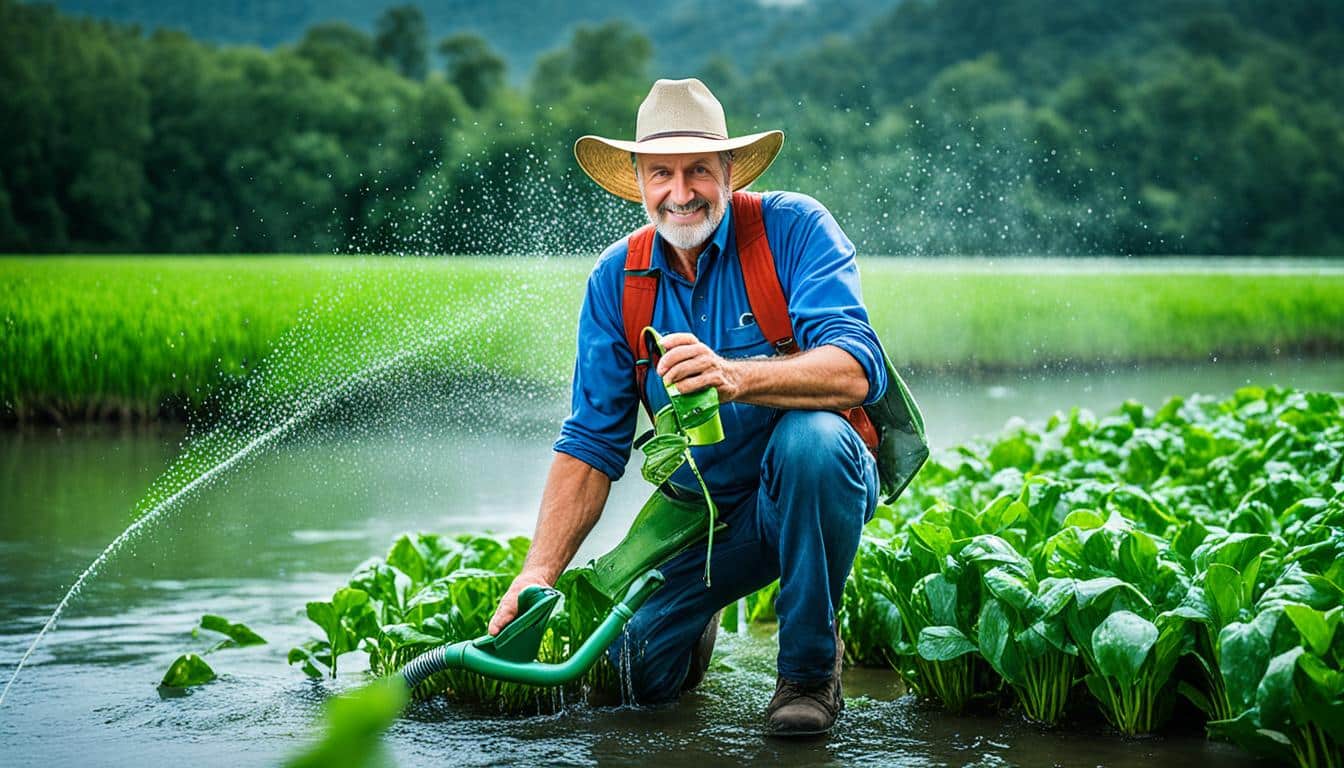
In the United States, 80 percent of all water goes to agriculture. This includes the water to grow crops and raise animals. It’s not just what we see. It’s also everything from making animal feed to processing foods.
When we talk about ‘water footprint’, we mean how much water is used to make things, like food. Knowing this helps us realise how much water we use to farm. For example, making beef needs a lot of water, around 15,000 litres for every kilogramme, mostly from rain.
Being water smart in farming is key. We should not just save water but use it better. This is so that farming can keep going in a way that’s good for the earth and everyone coming after us.
Water footprint in farming means looking at how water is used. It’s key to know that farming uses 92% of global water. This was between 1996 and 2005. This shows why calculating the water footprint is vital for agricultural sustainability.
Water footprint looks at how much water is used, in three types. It shows us the overall use of water by farms. This includes the water for the crops and that used by the whole production process.
The Water Footprint Network has made a tool to measure water use. It helps us see how we use water and where we can save. Managing water well can keep more water for non-farming uses. This is better than using it all up on farms.
Just think, making 1 kilogram of cotton uses 11,000 litres. And for one cotton shirt, it’s 2,700 litres. We see most of this water goes to watering plants and some is to clean up chemicals. This water management in farming is super important.
| Sector | Percentage of Global WF |
|---|---|
| Agriculture | 92% |
| Industry | 4.5% |
| Domestic | 3.5% |
Learning about water footprint helps us save water. It’s the first step to making farming less of a strain on water. With this knowledge, we can help make farming sustainable.
Water is essential for agriculture. It is the biggest user of the world’s water. This is mostly for growing crops and raising animals. So, it’s vital to use water wisely in farming for the future.
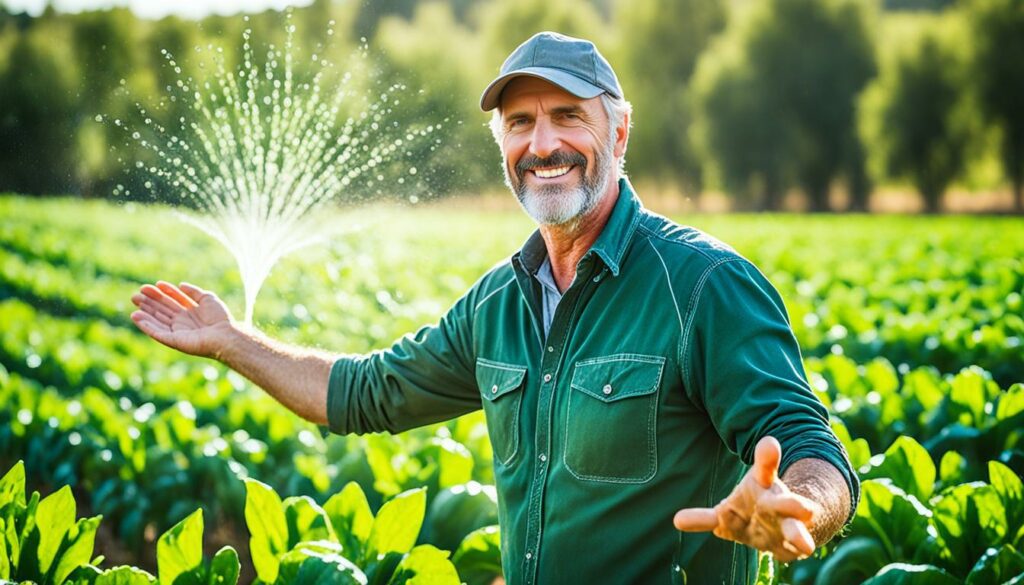
Agriculture uses a lot of the planet’s fresh water, about 70%. Much of this water goes to growing crops. Livestock farming, like for meat and dairy, also uses a third of this water. This shows the need to use water more efficiently in farming.
Nearly all the water used for raising animals is for growing their feed. So, using water wisely in agriculture is more important now than ever.
Let’s look at some key numbers about water use in farming:
Not having enough water is a big issue, even in places not thought to be dry. All sectors needing water, including farming, make this worse. To protect our water and grow food sustainably, we must find better ways to manage and save water in agriculture.
The water footprint in farming is affected by the crops grown, how they are grown, and the water sources used. Knowing these factors helps achieve sustainable farming. It also helps manage water use in farming better.
There are blue, green, and grey water footprints in farming. Blue is water from rivers and wells for crops. Green is rainwater that feeds crops. Grey uses water to clean pollution. They’re all important for water resource management.
The types of crops grown affect how much water they need. Some crops, like vegetables and fruits, use little water. They need less than 20 gallons per unit.
Others, like meat and chocolate, need much more water. For example, chocolate uses more water than beef ounce for ounce.
Choosing crops wisely and using efficient farming helps reduce water footprints. As farmers, we can pick less water-hungry crops. We can also use better irrigation and rotate crops.
| Food Products | Water Footprint |
|---|---|
| Meat Products | Exceeds 75 gallons per production unit |
| Chocolate | Higher than beef per ounce |
| Vegetables, Root Vegetables, Melons, Berries, Citrus Fruits | Less than 20 gallons per production unit |
It’s key to understand my water footprint and its parts. Knowing this can help use water better in farming. Contributing to eco-friendly farming is important for me. I aim to manage my water footprint effectively.
The choice of irrigation systems affects how much water is used in farming. In the U.S., 72% of water is used for farming needs. Irrigation efficiency is key. Traditional methods like furrow or flood irrigation lose a lot of water to evaporation and runoff. But, modern systems help save water by using it better, keeping crops healthy with less waste.
When we compare old and new irrigation ways, the difference is clear. In places where drought is a big issue, like the western U.S., people turn to modern methods. This includes drip and subsurface irrigation which save water by directing it right to the plants’ roots. However, old methods like spray irrigation waste up to 35% of water, and furrow irrigation can lose half of what’s given. Here’s a table showing how various irrigation types differ:
| Irrigation Method | Water Wastage (%) | Efficiency |
|---|---|---|
| Drip Irrigation | Less than 10 | High |
| Spray Irrigation | About 35 | Moderate |
| Furrow Irrigation | About 50 | Low |
| Subsurface Irrigation | Less than 10 | Very High |
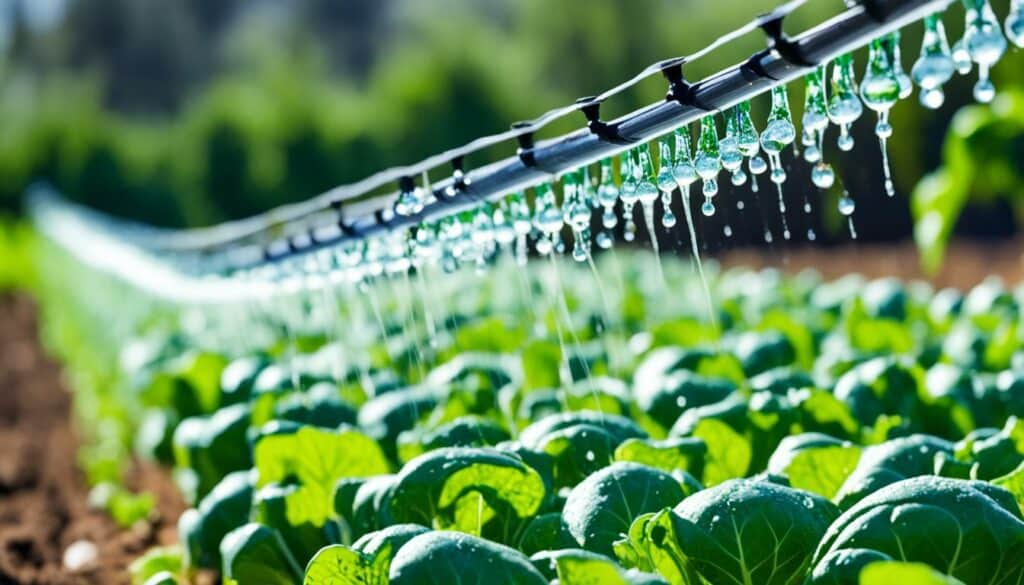
Many new technologies help save water in farming. Precision irrigation, for example, watches the soil and plants to apply water exactly when and where it’s needed. ASU teams up with local water projects in Phoenix to use these advanced systems, protecting precious water resources. As our tools get better, farmers can do more to save water, vital in the face of climate change and growing water needs.
Putting effort into modern irrigation is crucial. It helps manage water use and promotes smarter ways to grow crops. By embracing new technologies, we can join the fight to save water, ensuring a brighter farming future for all.
What we eat plays a major role in how much water farming uses. It’s important to know that different foods need different amounts of water. This understanding helps us choose foods that use less water, making our diet more sustainable.
Meat and dairy need a lot of water to produce. For example, making one pound of beef uses 1,800 gallons. In the US, 80% of water use is for agriculture, mainly for raising animals. Americans eat a lot of meat, about 181 pounds per person each year. This is almost three times the global average. So, our choice of meat and dairy affects water use a lot.
California is a big part of this problem because they produce a lot of milk, beef, nuts, and produce. We need to rethink how much meat and dairy we eat. This is key to tackling water scarcity.
Eating more plant-based foods can help cut water use. Plant foods generally need less water than meat and dairy. This change not only saves water but also helps fight climate change and reduces the need for vast areas of land. The water and health benefits of eating more plants show we can make a real difference by changing our diets.
Choosing plant-based foods can use up less water overall. For example, potato chips need less water to grow than meat. This means eating more plants can help us use water more wisely. It’s good for the planet and helps preserve water for everyone.
| Product | Water Footprint (gallons per pound) |
|---|---|
| Beef | 1,800 |
| Pork | 718 |
| Chicken | 518 |
| Wheat (whole grain) | 180 |
| Potatoes (whole) | 34 |
Understanding the water needs of different foods helps us make smarter choices. Going for more plant-based options and cutting back on meat and dairy are big steps for using water in farming more wisely.
Beef farming uses a lot of water. It needs around 2,000 gallons of water for every pound of beef made in the US. The amount of water can vary a lot, from 441 to 12,008 gallons. On average, producing a pound of beef uses about 1,850 gallons of water. This big water use is mainly due to cattle needing lots of water for their feed and care.
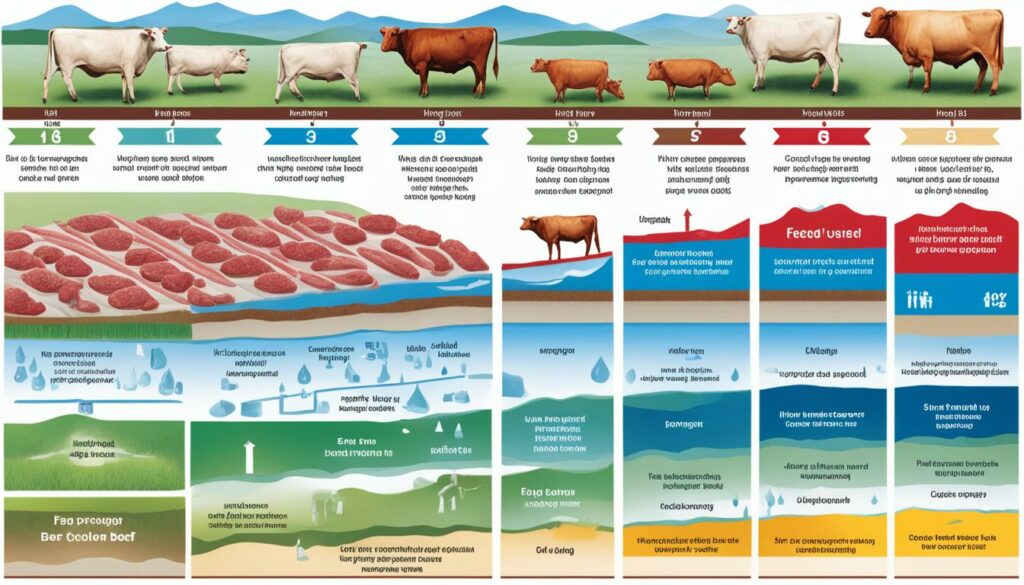
Producing beef goes through different stages. Calves are weaned at 6-10 months, then they graze until 12-16 months. After that, they eat a grain diet in feedlots. Each of these steps adds to the amount of water used to make beef. For example, other food items use the following amounts of water per pound:
| Food Item | Water Needed (gallons) |
|---|---|
| Pork | 720 gallons |
| Chicken | 520 gallons |
| Soybeans | 256 gallons |
| Wheat | 220 gallons |
| Corn | 148 gallons |
These numbers show that beef farming uses a lot more water than other protein sources. This highlights the need for better water use in raising livestock.
Using sustainable methods in beef farming can lessen the harm on the environment from using so much water. Beef that is raised on pastures and eats rainfed grass has a smaller water footprint. This also means it has less impact on the environment compared to beef produced in large systems. By changing what the cows eat and how they graze, water use can be reduced.
Checking how water is used on a farm is a crucial step. Farmers can then see where they can cut down on water use. Since a lot of beef comes from feedlots where cows eat corn and soy, changing this can save a lot of water. With many crops needing a lot of water, using less of them can help a great deal.
Climate change is hugely changing the world’s water resources. It’s making us realise how vulnerable these resources are. This is especially urgent in farming. The way it’s raining is different now, and we’re seeing more droughts. Over the last 20 years, we’ve been losing stored water every year. This affects how much water we have for the future.
Climate change is making life harder in many places. By 2050, more people will be at risk of floods and living without enough water. This particularly impacts agriculture. Around 20% of the world is seeing big changes in water levels. Some places are flooding, while others are drying up fast.
| Risk Factor | Current Impact | Projection by 2050 |
|---|---|---|
| Individuals at risk of floods | 1.2 billion | 1.6 billion |
| Severely water-scarce areas (population) | 1.9 billion | 2.7 – 3.2 billion |
Farming must adapt to these changes. Methods like growing crops that can handle less water and saving rainwater can help a lot. It’s important for farmers to think about how to use water better. New ways of farming can help lessen the effects of climate change. Using crops that need less water and smarter ways to water fields can make a big difference.
Looking at what’s happening now and what might happen, there’s a big need for new smart approaches. Farmers must plan carefully to protect and save water. Doing this is key to dealing with climate change and ensuring we have enough water.
Reducing water waste in farming is crucial. We must use water carefully because very little is available to us. By applying water precisely with tools like precision irrigation and soil sensors, farmers can cut down on waste.
To waste less water, we need to manage it well. Techniques like giving crops only the water they really need help a lot. For example, Steve Burke in Montana cut his water use in half with a new sprinkler system.
This not only uses less water but also saves a lot of time.
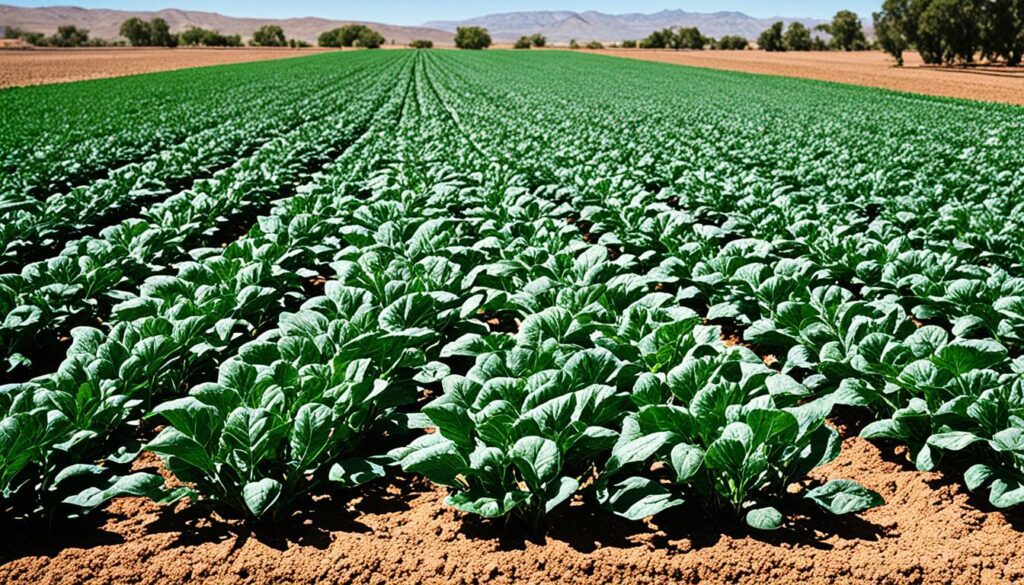
Technology is key to saving water in farming. Systems that adjust water use in the field are changing the game. Efficiency in agricultural water use is greatly improved through these methods.
By using these tools, farmers can save a lot of water. This helps keep water resources available and not wasted in their fields.
| Conservation Practice | Benefit |
|---|---|
| Precision Irrigation | Reduces water usage by applying it only where necessary. |
| No-Till Farming | Improves water infiltration and retention in the soil. |
| Smart Irrigation Systems | Optimise water use based on real-time data. |
Using methods like regenerative agriculture and organic farming is vital. Not only do these practices save water, but they also make the soil healthier. They also help more plants and animals thrive.
“Only three percent of the Earth’s water supply is freshwater, with only half a percent of that available for human use, equating to half a teaspoon if compared to a total water supply of 26 gallons.”
Steve Burke from Sheridan, Montana, cut his water use in half with sustainable farming. He used a new pipeline and a gravity system to water his crops and feed his animals. This shows the huge benefits of using less water on farms.
No-till farming is a big part of regenerative agriculture. Fields where they don’t plough have more organic stuff. This lets water soak in more and the soil keeps water better. So, it saves water and makes the land healthier.
There are over 160 ways farmers can help the environment. Agencies like the USDA are there to help farmers pick and use these methods. This one-to-one help makes sure farms use water the best way.
| Conservation Practice | Benefit |
|---|---|
| No-Till Farming | Higher organic matter, better water infiltration |
| Regenerative Agriculture | Enhanced biodiversity, improved soil health |
| Modern Irrigation Systems | Reduced water wastage, efficient water use |
Each day, the average American uses 2,050 gallons of water. Most of this water is used in farms. This is why using sustainable methods is so important. Organic farming is better for the planet and uses less harmful chemicals.
Green farming helps save water by keeping it in the soil. This stops water running off, taking dirt with it. If we don’t use water wisely now, farming will be hard in the future because of less water.
Virtual water means the water used indirectly to create different goods, mainly food. It’s a key part of water use with big impacts on food security worldwide and the balance of water in different areas.
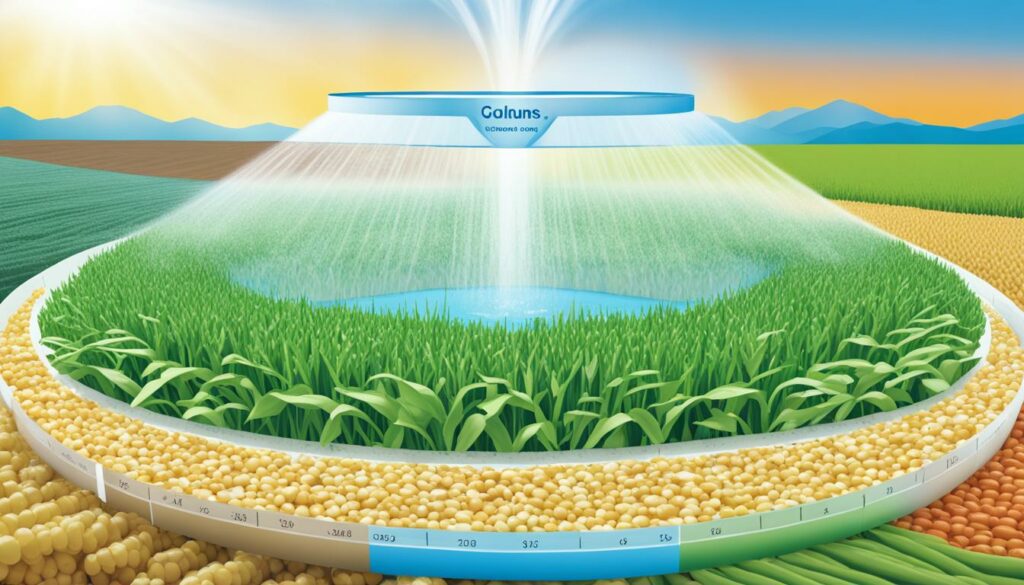
In today’s farming, trading virtual water matters a lot. It’s about moving water-heavy food from wet areas to dry ones. For example, the US sends water from the water-rich Midwest to dry Western and busy Eastern states. This movement is vital because in the US, farming uses most of the nation’s water, about 80-90%.
Knowing how much water it takes to grow our food is crucial for feeding the planet. Think of it this way: making a ton of wheat uses about 1,300 cubic meters of water. But a ton of beef needs a massive 16,000 cubic meters. This shows why we must manage how water moves around, which affects our ability to eat and the state of our world.
In the future, there will be much more water traded in foods. Experts think it might triple by the end of the century, due to water shortages caused by the changing climate. This could make water shortages worse globally, making it essential that we understand virtual water for our plans ahead.
So, keeping an eye on how we move water around for agriculture is key. It helps save water, deals with the rising problem of climate change, and keeps our food supply working well for everyone.
It’s vital to measure the water I use in farming to help the environment. I use tools to check how much water my farm needs. These tools help to make my farm more sustainable.
Water footprint calculators estimate how much water my farm uses. They look at different factors like what I grow, where I am, and when I plant and harvest. They show me how much water I use by type (like rain or fresh water). This helps me see where I can save more water.
A water audit on my farm measures every drop of water used. This means keeping track of water used to grow crops and what’s lost. With this info, I can see where I use the most water. Then, I can plan to use water smarter.
Doing these audits often stops me using too much water. It helps me keep my water use low. This way, I help protect water and the environment.
| Parameter | Description | Impact on Water Footprint |
|---|---|---|
| Crop Type | Different crops need different amounts of water | Water use changes based on the crop’s needs |
| Location | What climate and water are available affects water use | Changes how much I must water and manage water |
| Water Management | Using smart ways to water like precision watering | Helps me use water better, cutting down waste |
| Soil Type | The type of soil affects how well it holds water | Affects how I use water to grow crops |
| Irrigation Methods | Different ways to water, such as drip or flood | Shows how much water I use and save |
Using sustainable water management is key to saving water on my farm. Just three percent of Earth’s water is freshwater. And, only half of one percent is available for us. So, it’s critical to use water smartly to protect the environment.
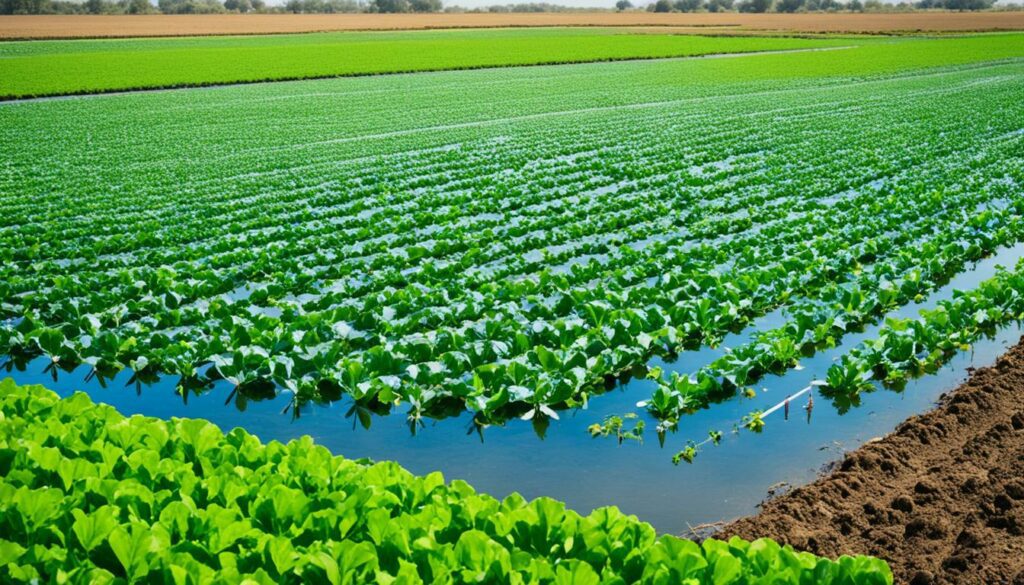
Rainwater harvesting is a great way to save water. This method collects rainwater for later use. It lessens the need for water from rivers and the ground, which helps the environment. Also, recycling greywater from showers and laundry can water crops. It’s a smart way to save clean water.
Taking care of water ways and keeping them healthy is crucial. Using no-till farming, which leaves old crops on the field, helps hold water in the ground better. This keeps the water clean and supports areas near the farm.
Modern techniques like drip irrigation can save lots of water. They’re up to 80 percent more efficient than the old ways. Using these methods on my farm helps in water saving and protects the environment.
“Fields planted with cover crops were 11 to 14 percent more productive than conventional fields during years of drought” — This highlights the potential productivity gains from adopting sustainable water management practices.”
| Strategy | Water Savings | Benefits |
|---|---|---|
| Drip Irrigation | Up to 80% more efficient | Reduced water usage, higher efficiency |
| Rainwater Harvesting | Reduces surface water dependency | Supports sustainable water sourcing |
| Greywater Recycling | Utilises household wastewater | Supplemental irrigation source |
Working with Arizona State University and local projects helps make water practices better. As we learn and do better, our farm helps save water now and for the future. This shows how important using clever water ways is.
Water usage in farming is set to change as the sector adapts to be more sustainable. With the help of new ideas, laws, and policies, how water is used in farming will transform. These changes are vital for the future of our planet.
Only a small portion of Earth’s water is fresh and usable by people. To put it in perspective, if all the world’s water was in a container, the amount usable by humans would be very small. Therefore, it’s crucial that farmers find smart ways to use water.
They can do this by updating their irrigation techniques and using methods that keep water in the soil longer. For instance, practices like not tilling the land too much can help. Not only does this help save water, but it also makes the soil healthier.
The food industry is also starting to reuse more water. It’s been found that between 72% and 79% of the water they use can be reconditioned and used again. In agriculture, mixing different strategies can also lower how much water is wasted. These new methods show that using water wisely is key for the future.
Creating good rules for using water in farming is very important. The USDA’s NRCS has made over 160 guidelines to help farmers use water more wisely. The people at NRCS centres give advice and support to farmers who want to follow these guidelines. This helps them grow food while taking better care of the planet.
Experts have looked at water use in farm crops and found that different crops use water differently. This shows that some farming methods are better at using water well. Laws and rules about farming water use are meant to protect the environment and help meet farming needs in a smart way.
The changing climate has a big effect on water use in farming. Research that looks at how climate change impacts crop growing highlights the need for farms to adjust. These adjustments are crucial for farms to keep producing food during changing times.
| Key Strategy | Impact on Water Usage |
|---|---|
| Improved Irrigation Systems | Reduces water consumption by up to 50% |
| High-Residue No-Till Practices | Increases water-holding capacity |
| Water Reuse in Food Processing | Achieves 72%-79% water reuse |
| NRCS Conservation Practices | Supports farmers in water conservation |
Reflecting on my journey to understand and manage my water footprint in farming, it becomes clear just how integral water conservation is to sustainable agriculture. The staggering statistic that agriculture in the United States consumes 80% of all water used through evaporation or other means underscores the critical need for informed water use in farming.
A pound of beef requires an average of 1,800 gallons of water to produce. This shows the high water demands of agriculture. Nearly 80% of beef cattle in the US consume water-intensive grain-based feed. It stresses water resources and highlights how global meat consumption accounts for 27% of the world’s total water footprint.
Water-efficient practices and sustainable water management techniques can help. Making conscious dietary choices is key to reducing my water footprint in farming. For example, choosing plant-based alternatives over animal products can save a lot of water. In California, managing water effectively is both a local and a global challenge. It requires a real commitment to water conservation.
The need for more food, driven by a growing population and climate change, calls for us to rethink our farming practices. By learning about and actively conserving water, we can make farming more sustainable. This way, we ensure a future where water is used wisely for the next generations.
A water footprint shows how much water is used to grow crops and raise animals until we eat them. It includes the water we see, like rivers and lakes (blue), the water from rain (green), and even the water invisible to us, like that which cleans pollution (grey).
We work out the water footprint by looking at the water used for farming crops and raising animals. This includes all types of water – blue, green, and grey. Calculating it helps us understand better how we can save water.
Water is key for farming, for plants and animals. It helps crops grow and keeps animals healthy. By using water carefully, farmers can help the environment and use less water.
Farming uses up to 90% of the water we cannot use again in the United States. This shows how important farming is for our water supply. It also tells us we need to use water on farms more wisely.
There are three types of water footprints in farming. Blue (from rivers and underground), green (from the sky as rain), and grey (to clean pollution). Each type is important for farming and the overall water supply.
Different crops need different amounts of water. For example, rice needs lots of water but maize can grow with less. Picking crops that don’t need as much water can cut down on water use.
Old ways of watering crops can waste water. But, newer methods like drips or sprinklers stop a lot of this waste. Using these can save water and make farming more efficient.
New technology helps farmers use water better. Things like soil moisture sensors make sure plants get just enough water. These tools help in saving water and protecting our environment.
What you eat can use a lot of water. Meat and dairy need more water than plants to grow. Choosing to eat more plants can help save water and protect the environment.
Producing beef uses a huge amount of water, about 15,000 litres for just one kilogramme. Most of this is to grow the food for the animals and keep them healthy. Using water wisely in beef farming is very important.
Climate change is making the weather unpredictable with more droughts. Farmers must find new ways to use less water. This includes growing crops that can survive with little water and collecting rain to use later.
Smart watering, using sensors to check the soil and not giving plants all the water they want, is good. Farming methods that save rainwater and reuse water from washing also help. These techniques make sure we don’t waste water on farms.
Farmers can do many things to save water. They can use methods that keep soil healthy and use less water. Choosing these farming ways helps both the land and the water.
Virtual water is the hidden water in the things we use. It is key for making food and goods and moving them around the world. Knowing about virtual water helps us use real water better.
You can figure out how much water you use for farming with special tools and checks. These tests can tell you where you use the most water. This way, you can improve and save water.
Good farming water care involves saving rainwater, reusing water from dishes, and keeping water in farms fresh and clean. These practices help keep the environment healthy and water flowing.
The future farm will use water much better, with new tools and ways. Rules that protect water and push for smarter farming will grow. These changes will make farming better for the land and water.